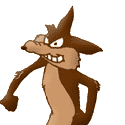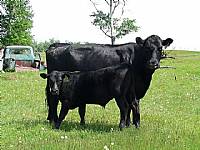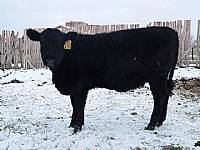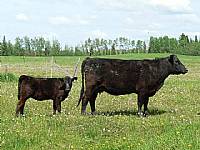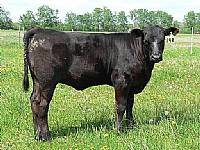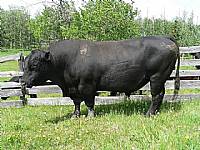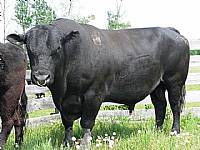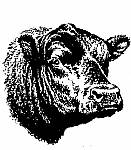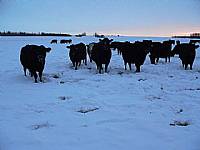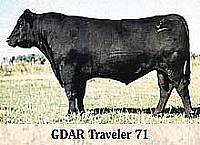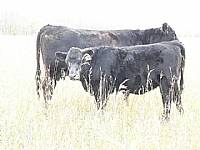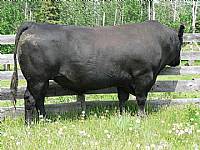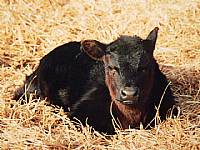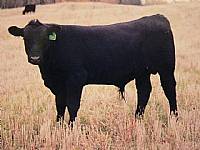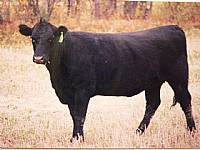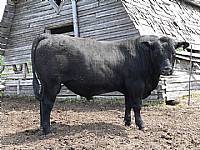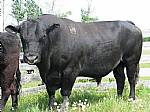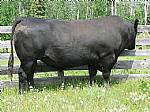
|
|
Angus herd information
Our Angus herd was started in 1994 with the purchase of a group of heifer calves from Darrel and Wendy Ashbacher , currently from Halkirk, Alberta. These heifers were A.I.d to GDAR Traveler 71 and Hoff Triumph. The resulting calf crop along with their mothers has made the basis of our herd. Other additions of females have come mainly from dispersal sales or the Northern Select Sale, held annually at Camrose, Alberta. Herdsires have been purchased from herds such as Everblack Angus of Vermilion, Remington Cattle Company of Del Bonita, Silver Dome Farms of Barrhead, Ashbacher Angus of Halkirk and also imported from the Montana herds of Westwind of Valier, and Paws Up of Greenough. Artificial insemination has also been continued to add different genetics and to produce home raised herd sires from our top cows. A variety of bloodlines have been used, some more successfully than others. The genetics of Traveler 23-4 and Tehama Bando 155 have had a major impact on our program, mainly through the use of their sons and grandsons. The selection of genetics to match our environment has led to some cow families becoming very prominent. The Erica family has become our favorite and most numerous. Selection criteria has been much the same as with the Polled Hereford herd but with one advantage, we had learned from some of our mistakes. Developing cattle that are optimum for our environment is an ongoing quest. To work towards this goal, we have selected mostly for balanced trait cattle while occasionally using an outlier to produce bulls for terminal use. Cows need to be fertile, able to calve unassisted, be able to raise a good calf while breeding back, be structurally sound, be of good temperament, and be able to do this profitably. This is not much to ask, but a lot to try to put together. Overall the idea of making cattle that are profitable for all segments of the industry while still pleasing the end users' taste buds is still our goal. After all if the consumer is happy with the product, they will pay for it and hence provide the money, which is needed to support each and every level below. Profitability for one segment of the industry cannot and should not be the only concern. If everyone can profit then everyone can survive. We think carcass traits are important but will not select for them at the expense of other traits. Yes, I know we are not going to produce the best at any one thing or have the highest EPDs, but I hope that we can produce some of the most economical genetics that can be profitable for our customers. Culling is continual and coupled with major culls during several drought years and another major reduction when we moved, our cow herd is probably stronger than ever. The top cow families have multiplied while many others have disappeared. The use of sons of top cows has worked well as a way of introducing new genetics that are already fairly adapted to our environment. Selection for herd bulls has been done using the idea that sons of older cows are more likely to ensure the convenience traits than using the hot new genetics. This being the idea, bulls from proven older cows have been sought out and used. Hopefully longevity will be an added bonus. Our main herd sire was lost due to an injury, but fortunately we have a supply of semen and will continue to use him for years to come. He is Paws Up 155 Bando 1475, a Tehama Bando 155 son off a daughter of D H D Traveler 6807. He is a well muscled, balanced trait bull who has consistently sired our best calves. His birth to yearling spread has widened with more use but he is appearing to be somewhat more of a true curve bender, as his coming 4 year old daughters are more moderate than their dams. Our other natural sires in use include a son of Paws Up 155 Bando 1475, another Paws up bull sired by Twin Valley Precision E161 and a Silver dome bull sired by Connealy Venture 4423 off a Canadian bloodline dam. We have flushed two Angus cows ,12 year old Erica female as well as her 10 year old daughter by GDAR Traveler 71. Cattle are registered with the Canadian Angus Association. Canadian semen is available on Paws Up 155 Bando 1475. Breeding stock available for sale. For available animals check out our sale barn. Angus history and information: The Angus breed was developed in the northeastern part of Scotland. The counties of Aberdeen and Angus had a major role in the breed's beginnings hence the name Aberdeen-Angus. The exact origin is not well known and early cattle were not of uniform color and some even had horns. It was found that references to polled cattle in Aberdeen and Angus occurred in about 1797. Scottish agriculture was making great progress and it was likely then that people started mating like kinds of cattle to like kinds from different areas. These polled cattle had gained considerable favor as producers of good carcasses. Hugh Watson, a breed founder started farming with 6 of the blackest cows and a bull from his father’s herd. He selected 10 heifers and the best bull he could find that showed the characteristics of the Angus cattle he was striving to breed. The females were of various colors but at this point Mr. Watson decided the color of his herd would be black and started selecting their offspring with that in mind. Many Angus trace back to Watson’s favorite bull Old Jock 126 and a cow called Old Granny 125, reportedly to have produced 29 calves and lived to the age of 35. Another founder, regarded as the “great preserver” was William McCombie who was a pioneer of planned matings. Mr. McCombie was credited with combining the Aberdeen and Angus as they were known at that time into the breed known as Aberdeen-Angus. The next real important herd , as far as North America is concerned, was the Ballindoch herd. George Grant transported 4 Angus bulls from Scotland to the Kansas prairie. The black bulls were labeled freaks in 1873 at Kansas City because of being polled and solid black in color. However Grant was a forward thinker and mated the bulls to the native Texas longhorn cows. The results were a large number of hornless, black calves that survived well on the winter range. This cross not only wintered better but also was heavier the following spring, an early indication of their value to the beef industry in North America. Today Angus can be found in their traditional black as well as red, derived from a recessive gene carried through many generations. Angus are still noted for their ability to produce excellent carcasses but have also become known for their maternal traits as well. PAWS UP 155 BANDO 1475
FEB 18, 2001
ANGUS
(1093553)
SEMEN
Contact us for pricing
CANADIAN QUALIFIED SEMEN AVAILABLE FOR SALE. PAWS UP 155 BANDO 1475 (1093553 CDN, USA 13967290) SIRES MODERATE FRAMED CATTLE THAT EXCEL IN STRUCTURAL SOUNDNESS WHILE STILL HAVING GOOD PERFORMANCE AND CARCASS TRAITS. NOT THE BEST IN ANY TRAIT BUT A VERY WELL BALANCED TRAIT SIRE, 1475 WAS LOST TO AN INJURY BUT WILL CONTINUE TO BE USED HEAVILY IN OUR PROGRAM THROUGH A.I.. HIS SONS HAVE MET WITH GREAT ACCEPTANCE BY OUR COMMERCIAL CUSTOMERS AND HIS DAUGHTERS ARE SOME OF OUR BEST YOUNG COWS, WITH BEAUTIFUL UDDERS AND THAT BROOD COW LOOK. BANDO 1475 CALVES ARE BORN EASILY AND ARE VIGOROUS AT BIRTH. DISPOSITION IS EXCELLENT. OFFSPRING ARE ALSO AVAILABLE FOR SALE, CHECK OUR OTHER LISTINGS OR CONTACT US FOR MORE INFORMATION.
|
||||||||||||||||||||||||||||||||||||||||||||||||||
